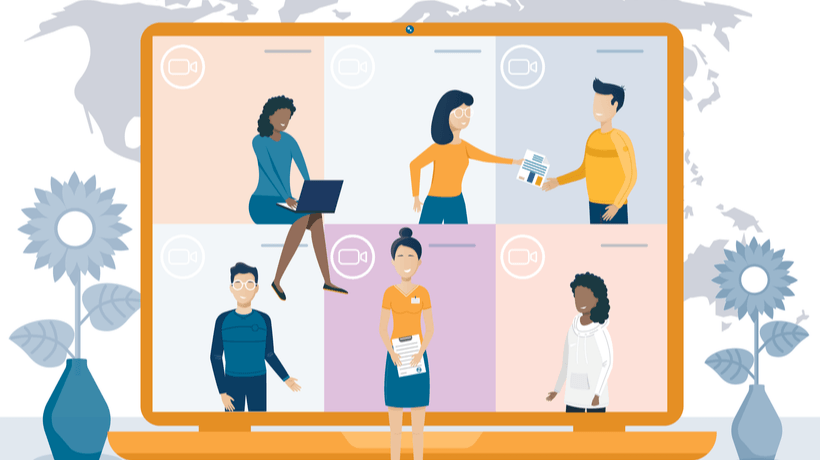How VILT Helped One Online Learning Company Overcome Challenges
In the eBook, Continuous Improvement For Virtual Training In Today's Business Climate, four global L&D thought leaders share stories of how the COVID-19 crisis influenced their training
strategies in 2020, and what they predict for the future of training in 2021 and beyond. This is the second VILT case study in our series, provided by Jo Cook, the Director of Lightbulb Moment.
The COVID-19 crisis has impacted all sorts of businesses, in a variety of ways. At Lightbulb Moment our work is to help develop the skills of teams of people to design and deliver live online learning that works, so our work was already virtual and remote. Whilst the volume of work increased and we needed to be able to offer what clients needed that was different from our longer courses, it was the change in the world our clients were living in that impacted us the most.

Dealing With The COVID Crisis
So many organizations had to react really quickly to being locked down and not able to deliver their normal face-to-face training. Some organizations had important training scheduled that had to go on regardless of the pandemic changes; some were further or higher education colleges that needed continuity of teaching for their students. In the corporate world, staff development and people’s needs didn’t go away with COVID-19—they might have changed, and in a lot of cases increased. So many individuals, teams, and organizations had to rapidly go live online when they never had considered doing so before. Some had mere days or hours to do that, and only hours to devote to getting their staff up to speed. Most organizations we helped went from nearly 100% face-to-face to 100% live online in a shorter time than they ever felt possible!
Challenges Faced...And Overcome With Virtual Training
Our “train the virtual trainer” programs can be just a few hours, but to develop the skills more deeply and have them embed we usually run 12 hours of live online sessions over a number of weeks, with various resources in between. During the early stages of COVID-19, in the spring and summer of 2020, companies didn’t have that time—let alone that budget—in order to develop the skills needed for their facilitators and trainers. We had to adapt by developing some much shorter individual sessions that focused tightly on what would help them most at that time. We emphasized that this wasn’t a full training experience, but it was enough to get people started.
The clients we were supporting had varying issues—some needed to convert their currently planned face-to-face sessions to deliver in a live online platform; others had new training initiatives that needed to be run, again in a different way from what they were used to. Because writing sessions for webinars or the virtual classroom relies on understanding our learning craft in a different way, it meant that the way these were created needed to be different. We offer a free live online learning facilitator guide template that helps people design interaction every few minutes with a variety of the platform tools, which is very different from how a lot of people work face-to-face.
Finding the Right Training Solution
We found that some clients had concerns about the effectiveness of moving to VILT, but this was lessened by the need to offer the teaching or training that was a necessity for them. As a company that provides training to trainers in how to work live online, we found that it was much more a conversation about changing people’s hearts and minds from thinking that this was a stop-gap poor alternative, and that it was actually a potentially great long-term solution!
Return on investment of the experiences of VILT compared to face-to-face hasn’t been the primary concern we’ve heard from our clients, partly because there was little choice about going to VILT. In some cases, businesses would collapse if that change didn’t happen, so there wasn’t a question about doing it or not. What we found that clients were asking for, in terms of outcomes for the training of their trainers, was two main things—for their own clients to be happy with the virtual training offering; and for the trainers to be confident in what they were doing. This is largely the start of a conversation we have when consulting about the right training solution for a team of people, so it’s interesting that it was even more focused on that during the first half of 2020.
Musings On The Future
Sadly, I’m not sure where we are going to be post-pandemic. As I write this in December 2020 in the UK, we’ve got to the worst stats so far. Is this the last of it, or just the beginning of more? At what point is a country and the world ‘post-pandemic’? For a least some of 2021 we will be still dealing with a pandemic world of restricted travel and contact with others. And when that does start to ease back to more social contact with others, what should happen for business and learning?
What I hope happens is what some people are calling a “hybrid” workplace, where people return to the office but there’s more working remotely where it’s appropriate and right to do so. I’m hoping that the flexibility and trust from organizations and their people are there to make this truly work now; that people have seen that they can use and rely on the technology to overcome and bring people together; and that they invest in the right technology, as well as the skills needed to use it, really well.
The Human Connection
At Lightbulb Moment we were already a remote company focusing on live online delivery, so in some sense that hasn’t changed for us this year. However, the experiences and needs of our clients, as well as their clients, has changed significantly. Through our training and resources, we want more than ever to show just how good virtual classrooms can be for connecting to other humans and for achieving learning that goes well beyond mere facts and basic skills. After all, we are training people in the very human and challenging skill in how to connect with another person and help them learn. That isn’t a simple skill when face-to-face, let alone getting over the perceived barriers of technology and distance.
We are building in much less focus on the technology and much more focus on that inter and intrapersonal connection, and how you can still read a room and feed off of the energy of a live online group of people. If enterprise L&D hasn’t changed because of reacting to the pandemic, we all better get different jobs!
What Learners And Facilitators Think About Our Approach
In our courses and in feedback afterwards, we hear overwhelmingly positive comments about working to deliver learning in live online classrooms. This is reacting to the behavior we model, with comments around the time going quickly and having not looked at their email once, through to really getting into the details in our six-session course to understanding digital body language to read people that they can’t see and so much more.
People tell us that their experience was “really warm and open so I felt really comfortable sharing my views”, that “it was an inclusive, friendly, and safe environment to learn in”, and someone also added that they were “inspired to have a go”. This is about us creating the right learning conditions live online for our attendees so that they can see it, hear it, feel it, and adapt it to what is right then for their attendees. They tell us that it does take time to learn and adapt, but also that they are making changes after just one session with us.
VILT Case Study Conclusions
Our feedback consistently shows that people are much more confident to work in virtual classrooms, which means that the sessions will be better and everyone’s approach will improve more and more over time. In short, it can be done, and it can be done well!
Download the eBook Continuous Improvement For Virtual Training In Today's Business Climate to discover Jo's best practices to help you continually develop your employee development strategy.









